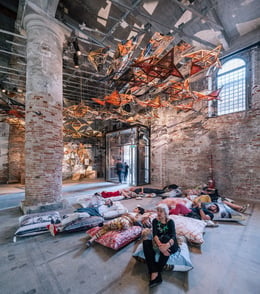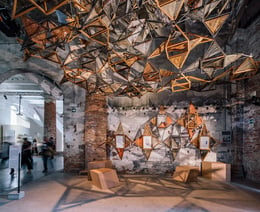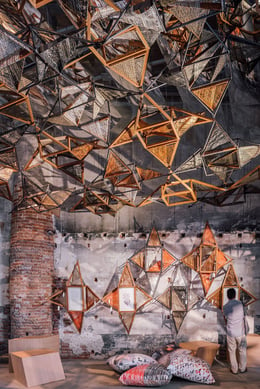Login
Registered users

A participative space as a manifestation of freedom: this is the idea behind the installation Weaving Architecture. Miralles Tagliabue EMBT’s project conveys how manual techniques, such as weaving, have the ability to humanize public spaces.
The poetic structure presented in Venice at the 16th International Architecture Exhibition of La Biennale di Venezia FREESPACE, curated by Yvonne Farrell and Shelley McNamara, is composed by various elements intertwined in two levels. The higher level is built with American red oak modules and the lower one with steel modules; and both are woven with fiberglass of different colors, which softens the visual effect and blurs the boundaries created by the structure.
Weaving Architecture summarizes a way of thinking stemming from Benedetta Tagliabue and EMBT's experimental work through the years, starting with the wicker Spanish Pavilion of Expo 2010 Shanghai. Progressing now in Clichy-sous-Bois and Montfermeil (in the outskirts of Paris) with the design of a metro station (part of the Grand Paris Express), a marketplace, an urban renewal, which will be built with fibers, a delicate material resistant through time and climate. Weaving Architecture deals with the concept of weaving at different scales: weaving the city through its metro, weaving activities of people in the public space, weaving the structure of the canopy to dress it with fiber fabrics. The canopy provides protection and shade, creating a comfortable, semi-open space for various communal activities. Its colorful nature expresses the spirit of Clichy-sous-Bois and Montfermeil by recalling patterns of African traditional clothing as well as local graffiti - an artwork owned by the people. This architecture, like the infrastructure it represents, links territories and builds a sense of social inclusion by manifesting architecture’s social role.
"Red oak not only has a minimal carbon footprint but is also truly sustainable”, explained David Venables, European Director of AHEC, one of the supporters of the installation. “The American hardwood forest, which occupies about 120 million hectares of the United States, has been well managed by successive generations of small landowners. Trees are selectively harvested and replaced through natural regeneration. The timber grows at a much higher pace than it is extracted and the forest increases by 401 hectares each year - the equivalent of a football pitch every minute”.
Two years ago, Benedetta embarked on a journey with the American Hardwood Export Council to demonstrate the potential of underused species, which despite growing abundantly in the forests are being underused because they are not in fashion. This journey started with The Workshop of Dreams, where she teamed up with Pritzker Prize Director Martha Thorne to create a series of coffee tables made in sustainable U.S. hardwoods. It continued with Too Good to Waste, an installation presented at Milan Design Week 2017, which opened up a dialogue about the need to use all the different species that the forests produce in order to achieve real sustainability. That is why when thinking about the material for Weaving Architecture American red oak was an obvious choice for EMBT. Thanks to those two projects, they had previous experience with this beautiful timber and were aware of its outstanding environmental properties.
Despite being a favorite in other parts of the world like the U.S and Asia, red oak is not being used in Europe. As AHEC’s European Director puts it: “Nearly one out of every five hardwood trees standing in the U.S. forests is a red oak, yet industries in Europe are reluctant to use it. We hope this project will inspire a more imaginative use of this beautiful and sustainable species”. The red oak components of Weaving Architeture have been fabricated in Madrid by the craftsmen at Intrama, a workshop with more than 30 years of experience in the field of architectural carpentry. Antonio Arce, Director of Intrama says: “We have been using red oak since the 80s, for some major projects such as the joinery of the Spanish Parliament. It is a species we like to work with because it is very noble, has a great look and is easy to work with”. And he adds, “In this project, Benedetta decided to use a very natural oil to finish the timber in order to highlight the wonderful grain of the red oak”.
RED OAK
Red oak is the dominant species in the U.S. hardwood forests with distinctive grain and wood that is not always red in color. The name is supposedly due to the Autumn leaf color. Red oak trees grow only naturally and almost exclusively in North America, although planted elsewhere. In general, the sapwood of red oaks is light brown and the heartwood is often pinkish to reddish brown. American red oaks have very good overall strength properties relative to weight. Its main uses are furniture, flooring, doors and certain construction applications. Forest Inventory Analysis (FIA) data shows that net annual growth of red oak in the U.S. after harvest is over 21 million m3, which means it only takes 0.57 seconds for the red oak used in Weaving architecture to be replaced in the forest by new growing stock.










